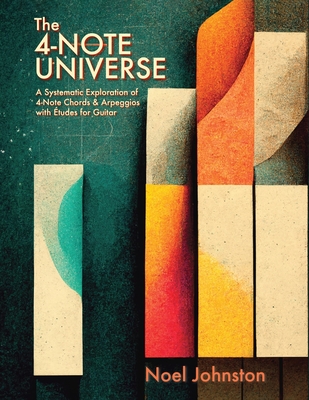The 4-Note Universe: A Systematic Exploration of 4-Note Chords & Arpeggios with Études for Guitar

The 4-Note Universe: A Systematic Exploration of 4-Note Chords & Arpeggios with Études for Guitar
INTRODUCTION
In a 12-Note system, there are 2047 chord types. 165 of them are 4-note sets (43 if you ignore inversions). When it comes to 4-note sets, most of us have heard of 7th chords: 1-3-5-7. Improvising musicians have explored the typical seventh chord arpeggios and voicings (∆7, Dom7, mi7, mi7(b5) and dim7) as an integral part of mastering both chord theory and their instruments. If you include inversions, those 5 chord types make up only 17 of the possible 165 4-note sets.
The systematic study of the remaining sets will give you a firmer grasp on the sounds that are possible, even when those sounds are difficult to label under traditional chord nomenclature. Exploring these alternative chords and arpeggios can yield interesting new sounds and, if mastered, can lead to a unique writing and improvising vocabulary.
As you practice and gain familiarity with these new sounds, you'll be able to:
a) have quicker recognition of these sounds when you hear/see/think about them, and
b) have greater access to these sounds on your instrument when you hear/see/think about them.
Feel free to work sequentially through this book, or to use it as a reference, skipping ahead to whichever types you'd like to explore. There are 5 main categories broken down into 43 groups. Within each group are various arpeggio, chord, and inversion shapes, along with concrete application: their tonal/scale contexts and an étude. Each of the 43 etudes are duets. You can play along with somebody or with the tracks provided, or use a looper pedal and learn both parts.
Ultimately, composing your own ideas is the best way to master new sounds... It not only requires that you deeply understand them, but it forces you to physically master whatever it is that you wrote.
PRP: 309.92 Lei
Acesta este Prețul Recomandat de Producător. Prețul de vânzare al produsului este afișat mai jos.
247.94Lei
247.94Lei
309.92 LeiIndisponibil
Descrierea produsului
INTRODUCTION
In a 12-Note system, there are 2047 chord types. 165 of them are 4-note sets (43 if you ignore inversions). When it comes to 4-note sets, most of us have heard of 7th chords: 1-3-5-7. Improvising musicians have explored the typical seventh chord arpeggios and voicings (∆7, Dom7, mi7, mi7(b5) and dim7) as an integral part of mastering both chord theory and their instruments. If you include inversions, those 5 chord types make up only 17 of the possible 165 4-note sets.
The systematic study of the remaining sets will give you a firmer grasp on the sounds that are possible, even when those sounds are difficult to label under traditional chord nomenclature. Exploring these alternative chords and arpeggios can yield interesting new sounds and, if mastered, can lead to a unique writing and improvising vocabulary.
As you practice and gain familiarity with these new sounds, you'll be able to:
a) have quicker recognition of these sounds when you hear/see/think about them, and
b) have greater access to these sounds on your instrument when you hear/see/think about them.
Feel free to work sequentially through this book, or to use it as a reference, skipping ahead to whichever types you'd like to explore. There are 5 main categories broken down into 43 groups. Within each group are various arpeggio, chord, and inversion shapes, along with concrete application: their tonal/scale contexts and an étude. Each of the 43 etudes are duets. You can play along with somebody or with the tracks provided, or use a looper pedal and learn both parts.
Ultimately, composing your own ideas is the best way to master new sounds... It not only requires that you deeply understand them, but it forces you to physically master whatever it is that you wrote.
Detaliile produsului










